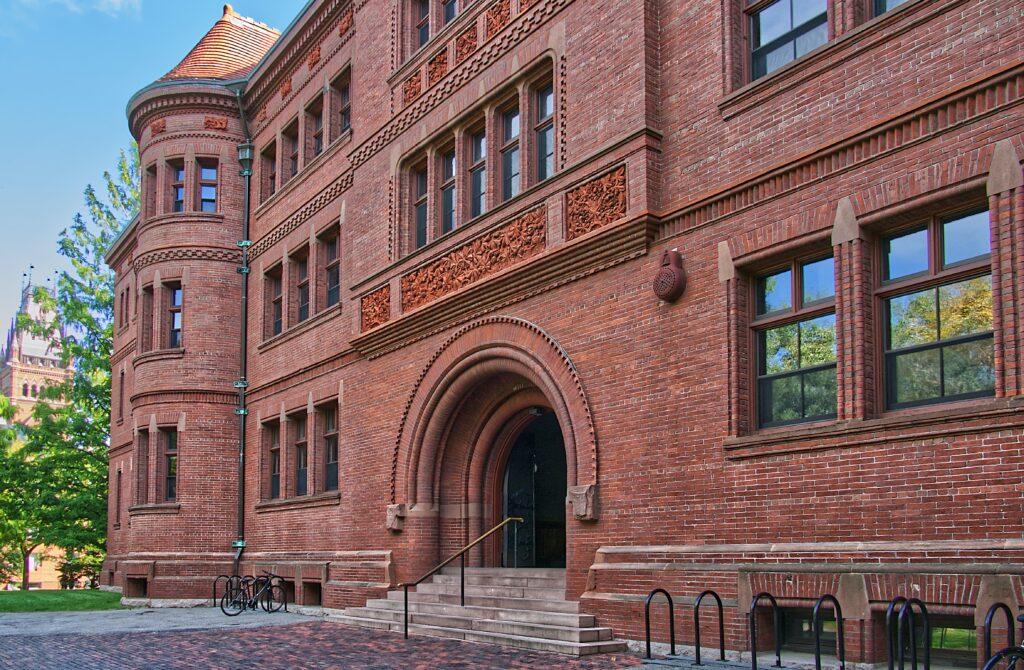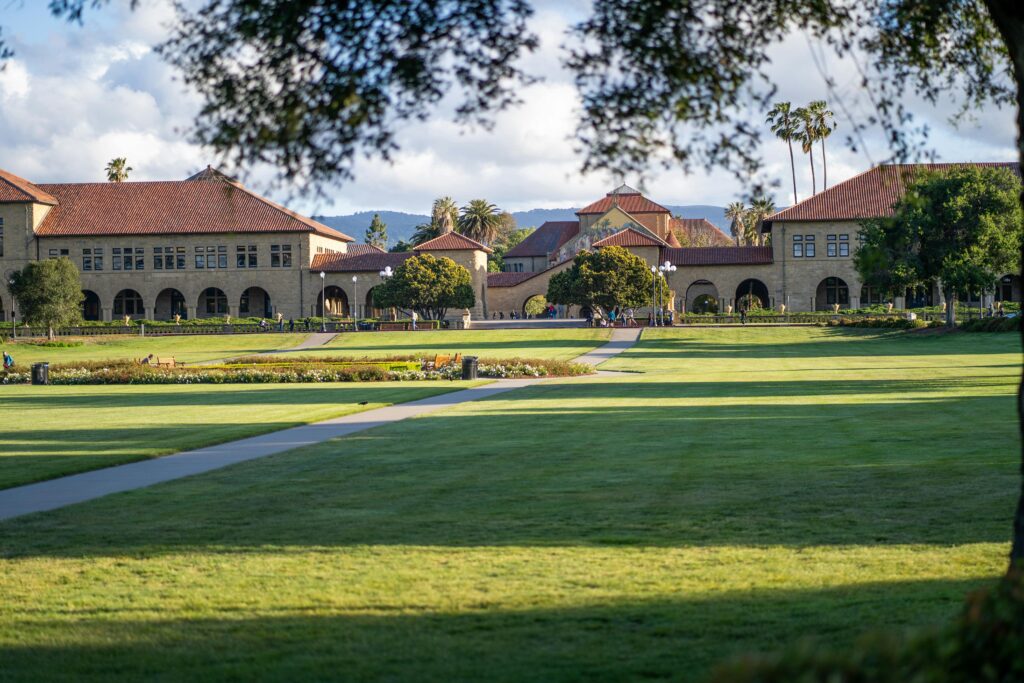
Harvard vs. Stanford: Comparing Top Schools
Picking the right college can be difficult — especially when comparing top universities like Harvard vs. Stanford. As two of the best universities in the nation, both Harvard University and Stanford University provide students a top tier education. Therefore, choosing between Harvard vs. Stanford will come down to your current and future goals. You’ll need to think about your personal and academic preferences and necessities, as well as essential factors like cost and location.
If you’re just getting to know these two schools, you might be asking yourself, “What is Stanford known for?” or “What is the Harvard enrollment?” Or maybe, “Which school is more affordable?”
In this Harvard vs. Stanford article, we’ll answer these questions and plenty more. Specifically, we’ll discuss:
- The Harvard and Stanford campuses and surrounding areas
- Harvard enrollment vs. Stanford enrollment
- Notable qualities of each school
- Harvard vs. Stanford rankings
- Academic opportunities at Harvard vs. Stanford
- Harvard and Stanford financial aid and tuition rates, and more!
By the end of this Harvard vs. Stanford guide, you’ll know how these two schools differ in academics, campus life, and resources. But first, let’s start with the basics: where are these schools located?
Where is Stanford?
Students interested in the best schools in California would be remiss not to consider Stanford University. Over 17,000 undergraduate and graduate students get to call Stanford’s 8,180-acre California campus home. But exactly where is Stanford located within California?
Just 35 miles south of San Francisco and 20 miles north of San Jose, Stanford’s neighborhood is known for its pioneering tendencies. The university is in Silicon Valley, a central hub of the Bay Area and home to many start-ups and tech companies. In fact, many of them are led or were founded by Stanford alumni.
Although Stanford is located in Silicon Valley, it’s not far from some breathtaking nature. Just west of the university are the Santa Cruz Mountains and the Pacific Ocean. On the other side, to the east of Stanford, is the San Francisco Bay. You can find hiking trails on Stanford’s campus, and the surrounding area of Palo Alto also has plenty of nature preserves and parks to explore.
Where is Harvard?
Over on the east coast, in the New England region, you’ll find one of the most prestigious universities in the world. Harvard University is located in Cambridge, Massachusetts, in the Greater Boston area. The historic Harvard campus is located just across the Charles River from Boston, giving students easy access to this historic city. The Harvard enrollment is large at over 20,000 full-time students, many of whom live on-campus.
Cambridge is known as a major academic hub, home to not only Harvard campus, but also the elite STEM university MIT. With around 50 institutions of higher education in the Boston area, Harvard is certainly a college town near a college city.
With a bustling art scene, Cambridge is also home to plenty of artists. The architecture, museums, street art, and green spaces within an urban setting make it a great place to explore. And, while not as synonymous with tech as Silicon Valley, the Greater Boston area is also a booming hub for technological innovation.
Is Stanford an Ivy League school?

For those asking the question, “Is Stanford an Ivy League school?”, there is a simple answer. No, Stanford is not one of the eight Ivy League schools.
The Ivy League first began as an athletic conference, comprising eight schools in the northeast. Ivy League schools are some of the oldest institutions of higher education in the nation, and have become prestigious thanks to their long history of academic excellence and notable alumni. Their alumni include presidents and government officials, Nobel Prize winners, decorated scholars, and other highly established graduates.
Today, Ivy League schools are considered some of the most elite and selective schools in the nation — and even the world. Year after year, you’ll see Ivy League schools ranking highly and drawing in plenty of applicants from across the globe. As such, they have extremely competitive admissions processes (and incredibly low acceptance rates).
There are of course excellent universities that are not a part of the Ivy League. Stanford University, for example, is often considered an academic peer to the Ivies and boasts an equally low acceptance rate, easily competing with even the highest Ivy League schools rankings.
Latest Harvard vs. Stanford Rankings
When comparing Harvard vs. Stanford, you may want to look beyond the Stanford and Harvard enrollment and locations to their rankings. While rankings aren’t always a good way to measure the fit of a school, they can help you compare and contrast them. This is especially true if you look at specific academic subject rankings or other areas of interest.
You might think that as an Ivy League school, Harvard University would dominate the rankings in comparison to Stanford. On the contrary, that’s not always the case.
Rankings from reputable college ranking institutions:
| College List | Harvard vs. Stanford Ranking |
| Forbes America’s Top Colleges | Harvard #8 – Stanford #2 |
| Niche Best Colleges in America | Harvard #4 – Stanford #3 |
| Times Higher Education World University Rankings | Harvard #3 – Stanford #6 |
| U.S. News National Universities | Harvard #3 – Stanford #4 |
As you can see, Stanford is ranked higher by Forbes and Niche. However, when ranked by Times Higher Education and U.S. News, the Harvard rankings are higher. Different sources use different criteria when ranking universities, which impacts relative ranks. Therefore, it’s important to consider the ranking system of different sources. For example, U.S. News factors in graduation rates, first-year retention rates, student-faculty ratio, borrower debt, and other criteria.
You might also consider searching the Stanford and Harvard rankings for your specific areas of interest. For example, a search for the best schools with undergraduate research/creative projects ranks Harvard at #7 and Stanford at #10.
However, when comparing Harvard vs. Stanford, remember to take college ranking lists with a grain of salt. What’s important to you may not necessarily factor into the ranking system of all sources. Rather than using rankings to decide which school is the best fit, do your own research into the factors that you care about. These can include academic programs, location, campus life, and student resources.
What is Harvard known for?

Most people have heard of Harvard, but why exactly is it so well known, apart from its elite status? Academically, Harvard excels in most areas, with over 3,700 courses for students to choose from. However, its academic reputation centers around being the best for law, government, business, and humanities.
With such a prestigious reputation, it’s no wonder that notable Harvard alumni include U.S. Presidents (Theodore Roosevelt, John F. Kennedy, and Barack Obama), prominent literary figures (E.E. Cummings, T.S. Eliot, and Henry David Thoreau), and even famous actors (Natalie Portman, John Lithgow, and Matt Damon). These are just a handful of the well-known figures who’ve graduated from Harvard University.
As one of the oldest universities in the nation, Harvard has certainly been influential in shaping American education. With its liberal arts and science values, it offers a unique interdisciplinary education, with plenty of research resources. Students are encouraged to pursue diverse curiosities and interests, ask difficult questions, and explore their passions.
Moreover, Harvard is able to provide such excellent education by having one of the largest endowments in the world. This endowment helps support almost every facet of the university, from academics to research to financial aid and much more.
What is Stanford known for?
When asking, “What is Stanford known for?”, you’ll likely hear answers referring to the school’s innovative spirit. But what is Stanford known for academically? Stanford is largely recognized for its strengths in STEM fields, including engineering and computer science, as well as business and entrepreneurship. It’s also among the most highly regarded research institutions in the nation.
While Stanford is known for its academic excellence all around, tech tends to be a strong field due to the university’s strong ties to Silicon Valley. In fact, Google got its start on Stanford University campus, where its founders, Larry Page and Sergey Brin, first met. Other notable Stanford alumni in the tech and business world include Brian Acton (WhatsApp co-founder) and Jerry Yang (Yahoo! co-founder and former CEO). DoorDash was also founded by four Stanford alumni who started the idea while living on the Stanford University campus. As you can see, many tech pioneers hail from Stanford University.
Stanford Research Park
The innovative and entrepreneurial spirit is so palpable that on the edge of Stanford University campus sits Stanford Research Park. This 700-acre space in the heart of Silicon Valley serves as a community for those who aim “to invent the future.” Its culture has made it a sought after place to found a business — many Stanford alumni have launched their headquarters here.
While Stanford has established itself as a hub for business and tech leaders, its academics focus on an interdisciplinary culture. This means that students collaborate and work across various disciplines. With this type of interdisciplinary education, students graduate better equipped to tackle and solve real-world, multifaceted challenges that require multiple perspectives and innovative solutions.
Research Universities vs. Liberal Arts Colleges

When comparing Harvard vs. Stanford, you might consider whether they are research universities or liberal arts colleges. Indeed, both Harvard and Stanford are considered research universities. However, Harvard is well known for its liberal arts education and Stanford is renowned for its interdisciplinary collaboration across different fields. So, if you can get a liberal arts education at both Stanford and Harvard, then why are they considered research universities?
Research universities have large budgets dedicated specifically to conducting and publishing research. More than anything, research is at the core of these universities’ mission: they prioritize acquiring and discovering new knowledge through research.
Liberal arts colleges, on the other hand, prioritize an interdisciplinary education that usually focuses on the humanities and social sciences. Rather than preparing for a specific job, students develop critical thinking and communication skills applicable to a variety of fields and careers.
While neither Stanford or Harvard is considered a liberal arts college, both schools emphasize a liberal arts education within a research framework. So, when considering Harvard vs. Stanford in this context, you might notice they have similar perspectives and priorities.
At Stanford, students can study at the School of Humanities and Science. There are 24 departments from which students can choose their majors. They also offer 25 interdisciplinary programs through which students can pursue the liberal arts at Stanford.
“Intellectual vitality” is at the forefront of the mission of Harvard College. The community within this college encourages members to question, speak up, and listen with respect. For those looking to embrace studying the liberal arts & sciences, Harvard provides arguably one of the best options in the nation.
Harvard vs. Stanford: Academic Opportunities
One of the most important factors to explore when deciding between Harvard vs. Stanford is academics. Do the majors and programs align with your interests and future career goals? Do they allow you the opportunity to grow and prepare for your career after graduation?
As previously mentioned, Harvard academics is well known for its historical strengths in humanities, law, government, and social sciences. Stanford, on the other hand, is prominent in fields such as engineering, computer science, entrepreneurship, and natural sciences. Let’s look at a few other important points to consider when evaluating the academic opportunities at Harvard vs. Stanford.
Curriculum and flexibility
Uniquely, Stanford University has a quarter system, meaning that their academic year is broken down into quarters. Students typically enroll in three quarters a year: fall, winter, and spring. With this system, students are able to take more classes per year.
On the other hand, Harvard has a typical semester system in which students enroll for fall and spring semesters. Classes are longer and focus on fulfilling general education requirements before moving into students’ chosen academic concentrations (at Harvard, majors are called “concentrations”).
Both schools allow students to double major, but their frameworks differ slightly. Stanford allows students to double major. At Harvard, meanwhile, students can pursue a joint concentration — this combines two majors, but with a lighter course load than a double major.
Research and internship opportunities
Luckily, when looking at Harvard vs. Stanford in terms of connections and opportunities, they both stack up quite well. With elite names, an extensive alumni network, and excellent locations, you can certainly find opportunities within your field at either school. And, as research universities, both Harvard and Stanford have faculty-led research for undergraduates to participate in.
However, if we get into specifics, Harvard has strong ties to the medical and public policy sectors. Stanford is known for being well connected to tech and innovation labs. As research universities, both schools have significant funding for undergraduate research grants as well as summer research programs.
Study abroad and global programs
What about Harvard vs. Stanford in terms of study abroad or international programs? Well, you’ll find options at both!
Harvard has a strong international presence and longstanding global partnerships. Students can study abroad for a year, semester, or summer through Harvard’s study abroad programs. Stanford also has a global program called the Bing Overseas Studies Program. Through this immersive cultural learning program, students can study abroad in global cities such as Madrid, Paris, or Berlin.
Graduate programs
On either the Stanford or Harvard campus, you’re guaranteed to find both undergraduate and graduate students. When comparing Harvard vs. Stanford’s graduate programs, many are curious about their business schools. So, when it comes to the Harvard vs. Stanford MBA, which elite school wins out?
In truth, it depends on you and your personal interests. The MBA program on the Harvard campus emphasizes a hands-on approach to learning. On the other hand, Stanford is known for graduating truly innovative thinkers and business leaders. (If you’re interested in an MBA at either of these top schools, keep reading! We’ll dive deeper into this specific topic later on.)
Harvard vs. Stanford Top Majors
To continue our comparison of Harvard vs. Stanford, let’s take a closer look at each school’s top majors. The top majors at each school reflect key differences in culture and focus.
First up in Harvard vs. Stanford majors, we’ll look at Harvard.
Top Majors at Harvard

Economics
Economics is one of the most popular majors at Harvard. Students take introductory courses in micro- and macroeconomics, then move on to tutorials where they’ll learn more advanced research methods and prepare to pose their own research projects. In fact, 25% of econ majors write a senior thesis.
Government
Often called political science at other colleges, government is another of the most popular majors at Harvard. Government students learn about theory, international relations, and American politics, all while building their critical thinking and analytic skills. Gov. majors must also take a methods course, like data science or statistics. These courses aim to prepare them to engage with and create political science research.
Computer Science
Often called CS, computer science has been a rapidly growing field in the last few decades. To major in CS at Harvard, you need basic mathematical proficiency. You’ll start your studies by taking Harvard’s (in)famous intro CS class: CS50. From there, students have the flexibility to pursue their own paths and explore fields like machine learning, cybersecurity, or computer science theory.
Applied Mathematics
To major in applied mathematics at Harvard is to prepare yourself for a dynamic and flexible career path, as “mathematical modeling is ubiquitous throughout the physical, biological, social, engineering, and management sciences.”
Neuroscience
Neuroscience majors at Harvard investigate the brain from different angles, including behavior and cognition and the actual biology of the brain. When debating between Harvard vs. Stanford, note that neuroscience students at Harvard can choose from three tracks: Neurobiology; Mind, Brain, and Behavior; and Computational Neuroscience.
Next in our comparison of Harvard vs. Stanford, let’s look at Stanford’s top majors:
Top Majors at Stanford

Computer Science
When looking at Harvard vs. Stanford, both schools have strong computer science majors that receive huge interest from their student bodies. Many recognize the CS program at Stanford as one of the best. It offers specializations in artificial intelligence, human-computer interaction, systems, and theory. When comparing CS at Harvard vs. Stanford, you may note that U.S. News ranks Stanford #1 in undergraduate computer science programs.
Human Biology
The human biology program at Stanford is an interdisciplinary, health-focused major that doesn’t exist in the same way at Harvard, making it a standout factor when comparing Harvard vs. Stanford. Popular among pre-med students, human biology looks at human beings from biological, behavioral, social, and cultural perspectives.
Economics
When it comes to Harvard vs. Stanford, the economics major is popular at both schools. Similar to Harvard’s major, Stanford’s program emphasizes both macro- and microeconomic proficiency. It also aims to teach students how to analyze real-world economic problems, preparing them for careers in both the public and private sector.
Symbolic Systems
Another interdisciplinary major, symbolic systems, is unique in the Harvard vs. Stanford comparison. In a world where artificial intelligence is becoming more prominent, symbolic systems engages students in the study of natural and artificial systems. Classes for this major cover cognitive science, computer programming, computational theory, probability, cognitive psychology, linguistics, and artificial intelligence.
Engineering
When looking at Harvard vs. Stanford, the engineering major works in a similar way at both schools. Each has a school of engineering, with more specific majors like bioengineering, mechanical engineering, and electrical engineering housed within the school.
These popular majors reflect the character and common career-outcomes of the two schools. At Harvard, many more students are looking to go on to careers in finance, government, or public policy. And, when you ask yourself, “What is Stanford known for?”, you’ll likely think of its pipeline and partnership with Silicon Valley. This is reflected in the school’s popular majors.
Next in the Harvard vs. Stanford comparison, let’s look at the campuses.
Which campus is better?

If you’re choosing between Harvard vs. Stanford, your decision may come down to something that has nothing to do with rankings or academics: the campus. Both the Harvard campus and Stanford University campus rank among our Best College Campuses in the U.S. So, let’s get a sense of what each of these beautiful campuses are like!
Harvard vs. Stanford architecture
Luckily, when considering the campuses in the Harvard vs. Stanford debate, they are radically different. The Harvard campus is the quintessential New England college campus. Indeed, most of Harvard’s buildings look like they’re from the era in which they were originally built. So when you see a colonial-looking building, you know it’s genuinely from the 17th or 18th century. (Founded in 1636, Harvard is one of the oldest colleges in the U.S. — even older than the nation itself). However, the Harvard campus also has newer buildings that may not fit the classic mold.
Alternatively, the Stanford University campus is more sprawling. It’s a classic California design, with palm trees dotting open promenades. The architecture leans more modern, and much of it is in the Mission Revival style, with sandstone buildings and red tiled roofs. Indeed, when you ask “what is Stanford known for?”, one of the best answers is the beautiful Stanford University campus.
Harvard vs. Stanford climate
If you’re considering Harvard enrollment, it’s important to think about the weather, too. Remember, the Harvard campus is in Cambridge, MA. This city experiences frigid winters and hot and humid summers. Many students embrace the extreme seasons, as attending Harvard and living on the Harvard campus is quite an elite opportunity. However, others prefer the ideal climate of California.
The Stanford University Campus is located in the sunny, temperate Bay Area. For those looking to escape east coast winters, Stanford provides an ideal climate for many, with mild weather year-round.
Students making up the Stanford and Harvard enrollment will enjoy opportunities to partake in outdoor activities like hiking and sports clubs. However, as you read in our “Where is Stanford?” section, Stanford’s beautiful weather and easy access to the Pacific Coast widens the range of potential outdoor pursuits: surfing, swimming, hiking, climbing, biking — you can easily access all of these and more from the Stanford University campus. You might have a more limited choice of activities from the Harvard campus.
Harvard vs. Stanford campus: which is better?
If you’re a lover of seasonal weather, Stanford may not be the place for you. But, if you want sprawl out reading your textbooks on the lawn, it could be your ideal campus. However, if the idea of snowy winters and four seasons enchants you, then you’ll prefer Harvard’s campus. Either way, it’s best to tour schools when possible.
Visiting Harvard vs. Stanford in-person may come down to which one is easier to reach from where you live. Thankfully, both schools offer virtual tours. So, whether you’re on the east or west coast, you can still get a feel for Harvard vs. Stanford’s campuses.
Comparing the Cost of Harvard vs. Stanford

When it comes down to cost, there’s no way around it — both Harvard and Stanford are expensive schools. However, both schools provide exceptional financial aid. Harvard especially stands out in this area with one of the most comprehensive tuition aid programs in the world. Like Harvard, the Stanford financial aid program is also incredibly comprehensive. The school is committed to meeting 100% of a student’s financial need in order to attend. Almost half of the student body receive Stanford financial aid.
Before we dive deeper into how Harvard and Stanford financial aid works, let’s look at how much each school will cost if you’re paying in full.
The tuition at Harvard is slightly less expensive than at Stanford. The total cost, including tuition, housing, food, and other fees, will set you back $82,450 per year. At Harvard, the large majority of students choose to live on campus and end up taking advantage of the meal plan.
At Stanford, the cost is quite a bit higher, closer to $93,000 a year. However, more students at Stanford decide to live off-campus, so you may have higher or lower total costs depending on where you live as well as your food and cooking preferences. Keep in mind, there is very little housing available in Palo Alto, and due to the tech boom, costs have skyrocketed.
Financial Aid: What school offers more?
When looking at Harvard vs. Stanford, it’s important to remember that both schools have incredibly comprehensive financial aid packages. Neither school provides merit scholarships, and both provide need-based aid. At Harvard, 55% of students receive some amount of financial aid, compared to nearly half of Stanford’s students. However, if you attend Stanford, you may also be eligible for state aid grants from California through the Cal Grant Program.
For families making $100,000, both Harvard and Stanford will cover 100% of the cost of college: tuition, room, board, etc. Starting in the 2025-26 year at Harvard, families making under $200,000 will pay no tuition, but will still have to pay other costs. At Stanford, that threshold is $150,000. Both schools offer financial aid for students with higher family incomes as well, and have their own method for determining how much aid to disburse. Additionally, both schools administer need-based and need-blind aid for international students.
While Harvard’s financial aid program may seem more generous on the surface, both schools use their own formulas to calculate financial need — so the actual aid a student receives can vary significantly depending on individual circumstances.
When it comes to financial aid, the most important takeaway is this: whether you pursue Stanford or Harvard enrollment, both schools will go above and beyond to ensure that their accepted students can attend — whatever their financial situation.
Harvard vs. Stanford MBA and Graduate Programs

If you’re thinking of attending graduate school, both Harvard and Stanford have incredible programs. When deciding between a Harvard vs. Stanford MBA, know that experts regard both highly. Additionally, both colleges have competitive law schools — Stanford’s law school is currently coming out ahead of the Harvard rankings.
If you want to go the business route, you’ll need to consider your specific interests and goals within the business world, as each school has different MBA concentrations. For example, Harvard Business School graduates largely go on to become CEOs of Fortune 500 companies, working in management consulting and finance. On the other hand, Stanford’s Graduate School of Business is more directed at people with entrepreneurial spirits who want to run startups.
Academically, HBS pioneered the case method. It asks students to look at different real-world case studies of instances where businesses needed a lift, and puts them in the role of decision-maker for how to improve a company’s circumstances. These are common in management consulting, and HBS is the premiere location for this type of teaching.
Alternately, at GSB, you’ll encounter more of a mix of lectures and case methods. Stanford also has a much smaller class size: around 400 students, compared to Harvard’s 900. Harvard’s alumni network is one of the biggest advantages of attending HBS. But in Silicon Valley, Stanford’s alumni network, though smaller, is equally mighty.
Other graduate programs at Harvard include the Kennedy School of Government, a unique political science-focused school, and the Medical School. Stanford’s School of Engineering also provides highly respected graduate degrees.
How to Compare Elite Universities
Though the answer to “is Stanford an Ivy League school?” is no, Stanford generally ranks up there with the Ivy League schools ranking. And with Stanford and Harvard rankings at #4 and #3 in the nation, respectively, choosing between the two isn’t all that simple. So, here are some helpful guidelines to help you compare Harvard vs. Stanford.
Compare the main features of each university: academics, culture, location, cost, and career outcomes. Then get real about what you want. Do you prefer a school in an urban location or something more suburban? What culture are you looking for in a college? Do you want to participate in Greek life? Do you want to have many peers pursuing similar fields, or are you looking for a varied group of people?
Most importantly, when comparing elite colleges like Harvard vs. Stanford, you need to think about the fit of each school for you personally. Every person is different, and some people may feel happier at different schools than others. Prioritizing your values, interests, and goals will help you explore “what is Stanford known for?” or “what is Harvard known for?” through your own eyes.
Don’t underestimate the value of a college visit. Walking around the campus can help you get a feel for what it’s like to attend that university, and sometimes you’ll just “click” with a school. You can also talk to current students and attend informational sessions with the admissions office to learn more about day-to-day life.
If you want to hear from current students, CollegeAdvisor puts together panels of Harvard and Stanford grads to talk about their experiences and the admissions process. Our College Finder Series also goes in depth about how to decide between Harvard vs. Stanford and plenty of other top schools!
Harvard vs. Stanford: 5 Benefits of Attending Each
Still deciding between Harvard vs. Stanford? Let’s look at five benefits of attending each, starting with Harvard.
5 Benefits of Attending Harvard

1. Global name recognition.
No matter where you go, all over the world, people know Harvard University. Just on name alone, going to Harvard will open many doors for you.
2. East Coast networking hub.
The Harvard alumni network is large and powerful, and bleeds into nearly every industry. Especially if you want to stay on the East Coast — Boston, New York, D.C. — Harvard’s connections will get you far.
3. Access to Boston-area resources.
Boston is an incredible city, with plenty of academic and professional resources. It’s home to many other elite universities like MIT and Boston University and has countless opportunities for recent grads to find work.
4. World-renowned faculty.
Harvard’s faculty is unbeatable. Because of its name recognition, Harvard gets its pick of professors from all over the world. You’ll meet people who have served under presidents and world leaders and researchers and academics at the top of their fields.
5. Quintessential liberal arts college experience.
If attending a charming, dreamy liberal arts college appeals to you, you can do no better than Harvard. Once you see the leaves fall on Harvard Yard or watch the crew team row down the Charles River, you’ll feel like you’ve stepped into a movie. Plus, unlike other smaller liberal arts schools, Harvard has a liberal arts feel while still being a research university — you can have unbeatable STEM instruction amidst the brick and ivy.
Now, let’s check out some pros of attending Stanford.
5 Benefits of Attending Stanford

1. Proximity to Silicon Valley and tech startups.
What is Stanford known for? Mainly, its connection to Silicon Valley. If you’ve dreamed of starting the next Uber, you’ll find your co-conspirators at Stanford.
2. Interdisciplinary innovation.
Many of Stanford’s majors are interdisciplinary and focus on pairing STEM innovation with social sciences and humanities. The curriculum aims to make you a better thinker and person, whatever career you pursue. Certainly, you’ll have an edge against those with a more traditional educational background.
3. Top programs in engineering and computer science.
If you want to study computer science or engineering — essentially, if you want to work in tech — Stanford may be the better choice for you.
4. Startup-friendly academic ecosystem.
The professors at Stanford know the culture they’re cultivating, and they want you to succeed in your entrepreneurial endeavors.
5. Beautiful weather and campus year-round.
Where is Stanford located? Well, it’s in sunny California, where the summers are hot and the winters are milder than they would be on the East Coast. If you love the outdoors and dread winters, there’s no better place to be.
Harvard vs. Stanford – Final Takeaways
Harvard and Stanford are both such incredible schools. If you’re lucky enough to get to choose between taking the next step toward Stanford or Harvard enrollment, here are some things you may want to think about.
Harvard vs. Stanford Key Takeaways

Both Stanford and Harvard are elite schools offering a superb academic education.
While the answer to “is Stanford an Ivy League school” is no, Stanford is still up there with the Ivy League schools rankings.
Harvard offers a more traditional blend of liberal arts and research education, whereas Stanford has more unique interdisciplinary offerings.
Many Harvard graduates go on to more “traditional” careers, like politics, law, consulting, or finance, whereas Stanford is a pipeline to tech dreams and startups. It’s not black and white — many Harvard students also go into tech, and Stanford students go into law — but if you’re looking for a way to compare, this can be a helpful guiding principle.
Harvard and Stanford have very different campuses with different vibes.
Harvard is located within the city of Cambridge. It’s a smaller, urban campus with a charming, old-world feel. Stanford’s campus, however, is sprawling. In fact, university designer created the campus to help students get outdoors and soak up the sun.
Harvard and Stanford both have renowned graduate programs.
Their MBAs are some of the best in the country. Harvard’s MBA is geared more towards case studies and finance, whereas Stanford’s is more directed at — you guessed it — startups and tech.
Harvard and Stanford offer incredible financial aid.
Both schools aim to make enrolling more financially accessible with free attendance for families making less than $100,000.
If you’re still stumped on which colleges to apply to, CollegeAdvisor is here to help. With one-on-one advising and free guides like this one, we have plenty of resources and expertise to support you as you navigate choosing a college. And, if Stanford or Harvard is your dream school, we can help with that too, with everything from essay editing and guides to insider admissions advice.

Sarah Kaminski and Rachel Kahn collaborated on this article. Looking for more admissions support? Click here to schedule a free meeting with one of our Admissions Specialists. During your meeting, our team will discuss your profile and help you find targeted ways to increase your admissions odds at top schools. We’ll also answer any questions and discuss how CollegeAdvisor.com can support you in the college application process.
